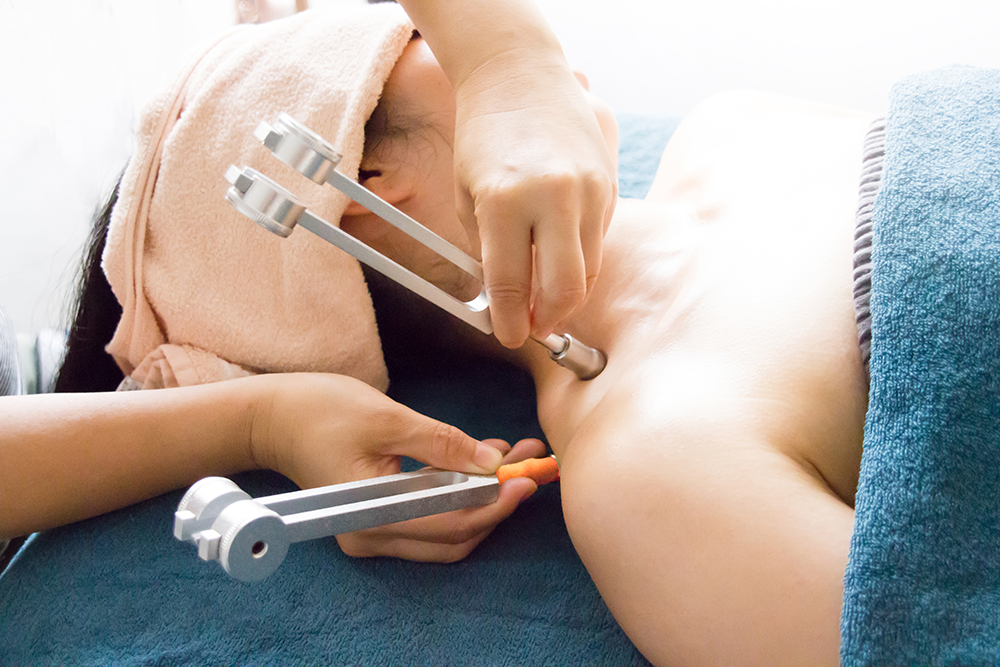Expert Advice

Acella Pharmaceuticals, LLC, is partnering with Ericca Burke, a board-certified licensed acupuncturist, to bring greater awareness to the importance of thyroid care and education. This post was sponsored by Acella Pharmaceuticals and should not be construed as medical advice. Please talk to your doctor about your individual medical situation.
Tuning forks are U-shaped metal tools that vibrate at specific frequencies when activated. The size of the fork determines the musical note and sound that emanates from the tuning fork. Sound is a powerful healing modality, and tuning forks emit healing vibrations.
Tuning Fork Benefits on Acupuncture Points
Tuning forks can be used on acupuncture points to stimulate the points. This application of gentle pressure to acupuncture points is referred to as acupressure, and in this case, the tuning forks are used as acupressure tools. Through the principle of entrainment, the human body naturally adjusts its vibration to synchronize with the tuning fork. This concept of entrainment can be observed when a series of metronomes are started at different times. After a period of time, they will always come into synchronization with one another. You can see this synchronization in stores that sell clocks with pendulums, like grandfather clocks. The clocks in the store all move in rhythm with one another.
Gem Therapy with Tuning Forks
Specialized tuning forks have tips that can be removed and interchanged with other tips that have gemstones. Gemstones have been used in Chinese medicine for their healing properties for thousands of years. Each stone has unique healing properties. This combination of tuning fork and gemstones amplifies the healing potential since the gemstones also resonate with the various energetic centers and pathways of the body.
For example, lapis lazuli has a resonance with the kidney energetic pathway and can nourish kidney energy to help with hypothyroidism. In Chinese medicine, the kidney is associated with water and the color blue. Adding a lapis lazuli gem tip to a tuning fork would enhance a treatment to support the thyroid.
Tuning Fork Therapy for Patient with a Thyroid Disorder
Tuning forks can be applied to acupuncture points to support the thyroid. In the case of hypothyroidism, points along the kidney energetic channel, or pathway, would be selected because the kidney channel is associated with the hormones as well as the thyroid. The kidney channel starts on the underside of the foot and runs up the inner aspect of the leg and to the abdomen, and ends at the top of the rib cage.
Additionally, points along the conception vessel and governing vessel energetic channels may be selected because they support the kidney channel. The conception vessel runs along the center of the abdomen up the front of the body, and the governing vessel runs along the spine up the back of the body. Just as every person is unique, each treatment is customized to the patient and their specific needs.
Benefits of Tuning Forks
Tuning forks are very gentle, and they are a great option for patients who are too sensitive for needles or may be scared of needles. The tip of the tuning fork softly touches the skin of the patient. Some patients experience a subtle vibration in the body that is soothing and relaxing. Other patients don't feel much of the vibration and instead, feel grounded and calm. Tuning fork treatments can be a good way to help people get used to the concepts behind acupuncture treatments until they are ready to try needles. Tuning forks can also be used in conjunction with acupuncture needles, depending on the needs of the patient.
How Tuning Fork Treatment Works
Typically during a tuning fork treatment, a patient will lie comfortably on a massage table. The practitioner will hold the forks and activate them. This is done by gently striking the fork against an activator or by snapping the two tines of the forks. Once the forks are activated, the tips are placed on acupuncture points. The tuning forks can also be gently moved up and down the spine or any area that needs attention. Tuning forks come in a variety of frequencies, and the practitioner will determine the appropriate forks to use based on the needs of the patient. Tuning forks also can be held near each ear to allow the patient to listen to the sound coming from the fork, which can be very relaxing and soothing. Treatments will usually start and end with the tuning forks being held at the bottom of the feet to ground the patient.
When considering tuning fork therapy, it is recommended to select a practitioner who is certified to use tuning forks by a program such as Acutonics.
Note that DTE products, including NP Thyroid®, have not been reviewed by the FDA for safety or efficacy.
IMPORTANT RISK INFORMATION, INCLUDING BOXED WARNING & INDICATIONS
Important Risk Information
Drugs with thyroid hormone activity, alone or together with other therapeutic agents, have been used for the treatment of obesity. In euthyroid patients, doses within the range of daily hormonal requirements are ineffective for weight reduction. Larger doses may produce serious or even life-threatening manifestations of toxicity, particularly when given in association with sympathomimetic amines such as those used for their anorectic effects.
- NP Thyroid® is contraindicated in patients with uncorrected adrenal insufficiency, untreated thyrotoxicosis, and hypersensitivity to any component of the product.
- In the elderly and in patients with cardiovascular disease, NP Thyroid® should be used with greater caution than younger patients or those without cardiovascular disease.
- Use of NP Thyroid® in patients with diabetes mellitus or adrenal cortical insufficiency may worsen the intensity of their symptoms.
- The therapy of myxedema coma requires simultaneous administration of glucocorticoids.
- Concomitant use of NP Thyroid® with oral anticoagulants alters the sensitivity of oral anticoagulants. Prothrombin time should be closely monitored in thyroid-treated patients on oral anticoagulants.
- In infants, excessive doses of NP Thyroid® may produce craniosynostosis.
- Partial loss of hair may be experienced by children in the first few months of therapy but is usually transient.
- Adverse reactions associated with NP Thyroid® therapy are primarily those of hyperthyroidism due to therapeutic overdosage.
- Many drugs and some laboratory tests may alter the therapeutic response to NP Thyroid ®. In addition, thyroid hormones and thyroid status have varied effects on the pharmacokinetics and actions of other drugs. Administer at least 4 hours before or after drugs that are known to interfere with absorption. Evaluate the need for dose adjustments when regularly administering within one hour of certain foods that may affect absorption.
- NP Thyroid® should not be discontinued during pregnancy, and hypothyroidism diagnosed during pregnancy should be promptly treated.
Indications
NP Thyroid® (thyroid tablets, USP) is a prescription medicine that is used to treat a condition called hypothyroidism from any cause, except for cases of temporary hypothyroidism, which is usually associated with an inflammation of the thyroid (thyroiditis). It is meant to replace or supplement a hormone that is usually made by your thyroid gland.
NP Thyroid® is also used in the treatment and prevention of normal functioning thyroid goiters, such as thyroid nodules, Hashimoto’s thyroiditis, multinodular goiter, and in the management of thyroid cancer.
Revised
10/2023
You Are About To Leave This Website
By clicking continue, this link will take you to a website to which Alora Pharmaceuticals’ Policies & Terms of Use do not apply.

